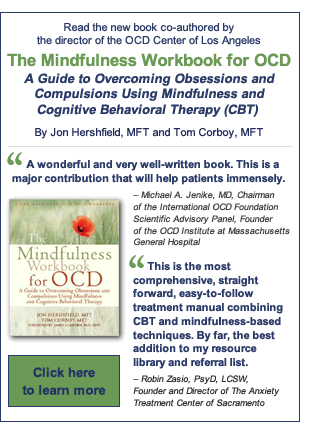
especially for those with Pure Obsessional OCD
(sometimes called “Pure O”).
Over the last few weeks, I have had a secret. For most people, this secret would not have been seen as important, but to me it was. Every time I had these thoughts I became overwhelmed with anxiety, fear and an almost palpable sense of terror. As soon as the thought of this secret flashed through my mind, I would have visions that would take me to its worst-case outcome. As I played these thoughts out in my head, I physically experienced extreme anxiety, as if the discovery of my secret was actually happening.
Just a few days ago, I was on the treadmill and the thought flashed through my mind again. I was immediately plagued with heightened anxiety. Even the lady on the treadmill next to me noticed and commented that my face had a strange look on it. In response to the thought, I did what most people would do. I tried not to think about it.
At that point, I started a conversation with the lady next to me…and the thought popped up in my head. After the conversation was over, I read a trashy magazine… and the thought popped up in my head again. I then began running as fast as I could, dripping with sweat and breathing deeply, and the thought still managed to surface. Actually, not only did it surface, but it continued to inflate in my head, as if it was going to soon explode.
I got off the treadmill, and it was only then that I realized what I had been doing. I was trying to suppress an unwanted, intrusive, anxiety provoking thought. Even though I discuss this concept daily with my clients who suffer with Obsessive Compulsive Disorder (OCD) and anxiety, I had forgotten it for myself, and had spent over an hour trying to push away these scary thoughts instead of embracing them.
Thought Suppression Research
Thought suppression is a common feature seen in OCD, especially for those who suffer with what is sometimes called Pure Obsessional OCD, or “Pure O”. But nobody wants to have anxiety provoking thoughts. When we experience unwanted, distressing thoughts, we quite naturally respond by trying to control them, ignore them, or push them away. Unfortunately, many clinical studies have proven that trying to suppress unwanted thoughts usually results in the person experiencing the thoughts more often and in a more intense way. That was definitely the case for me.
The concept of “thought suppression” was first studied by Wegner, Schneider, Carter, and White in 1987. In this study, a group of people were asked to not think about (or to suppress thoughts of) white bears for 5 minutes. During this time, participants were asked to verbalize their thoughts and ring a bell each time they thought about a white bear. Following this initial 5-minute period, participants were then asked to purposely think about white bears for another 5-minute time period. The results showed that participants reported thinking about white bears almost twice as often in the 5-minute period during which they were asked to not think about white bears.
If you suffer with intrusive thoughts, you may ask “Why doesn’t this happen with all of my thoughts? Why is it that I always remember and I am always plagued by these intrusive thoughts, yet I can forget many of the items on my grocery list?” The answer is simple – the items on your grocery list are not anxiety provoking, and you are not trying to forget them. The problem with trying to suppress unwanted, anxiety provoking thoughts is that the more effort you put into forgetting these thoughts, the more likely you are to be unable to forget them.
Treating Intrusive OCD Thoughts
So, if you have ever experienced the angst of unwanted, intrusive thoughts…or if you are curious about my secret, you might be wondering “How can I get those horrible thoughts out of my head?” or “How did she get those thoughts to go away?”.
The most effective approach to take in managing intrusive, unwanted thoughts is Cognitive Behavioral Therapy (CBT). And the most basic tool in CBT is what is commonly known as Cognitive Restructuring, in which a person with an unwanted thought briefly and objectively reviews the thought. For example, when I stopped to look at my secret thought, I immediately realized that it was neither rational nor realistic. I identified it as such, and assigned it an alternative thought that I could use to challenge the thought when it next arose.
Unfortunately, for those with OCD, Cognitive Restructuring can quickly become a compulsion in itself. We have treated many people who are unable to get the benefits of Cognitive Restructuring because they quickly resort to compulsively analyzing their thoughts (and the alternative thoughts they come up with to challenge their unwanted thoughts) in an attempt to control them.
 For this reason, a different approach is needed. When faced with intrusive, unwanted, anxiety provoking thoughts, the most effective long-term cognitive tool is what is commonly called “mindfulness”. From a mindfulness perspective, when one experiences intrusive, unwanted, anxiety provoking thoughts, the goal is not to attempt to reject them or or push them away, but rather to allow and accept their presence in your mind – to have a more open and peaceful relationship with them. This doesn’t mean that you need to enjoy the thoughts or accept the legitimacy of their content. It merely means that you accept reality as it is…and reality is that these thoughts are in your head. Think of it as being similar to accepting a rainy day when you had planned to go to the beach – you may not like the rain, but you will be a lot happier accepting it and getting on with your day than you will be if you get angry at the rain for existing.
For this reason, a different approach is needed. When faced with intrusive, unwanted, anxiety provoking thoughts, the most effective long-term cognitive tool is what is commonly called “mindfulness”. From a mindfulness perspective, when one experiences intrusive, unwanted, anxiety provoking thoughts, the goal is not to attempt to reject them or or push them away, but rather to allow and accept their presence in your mind – to have a more open and peaceful relationship with them. This doesn’t mean that you need to enjoy the thoughts or accept the legitimacy of their content. It merely means that you accept reality as it is…and reality is that these thoughts are in your head. Think of it as being similar to accepting a rainy day when you had planned to go to the beach – you may not like the rain, but you will be a lot happier accepting it and getting on with your day than you will be if you get angry at the rain for existing.
The most important component in managing unwanted thoughts is changing one’s behavioral response to these thoughts. People with OCD often try to control and/or avoid their anxiety-provoking thoughts. Unfortunately, as noted above, this only results in having more of the same thoughts.
While it may seem counter-intuitive, the most effective behavioral response to unwanted thoughts is to allow them to exist while making no effort whatsoever to control or change them. In fact, if you really want to challenge these thoughts, the best approach is to purposely choose to have them. If you do this, you will soon discover that you have de-fanged these thoughts. You may still have these thoughts – after all, many people, including those without OCD, have similar thoughts – but you will care far less about them. They are, after all, just thoughts
So how did I deal with my “secret”? Using the above techniques, I accepted that the thought was not that important and that it did not require such a heightened and lengthy response. I accepted that this thought is no more important than most of the thoughts I have on any given day, such as “what color shirt shall I wear” or “what will I have for lunch” or “should I shower before or after dinner”. The most important thing to remember is that suppressing the thought will only make it stronger. Avoidance will almost certainly not make the thought go away.
I am assuming the fact that you have read this far means that either a) you have experienced the distress and aggravation of failed attempts to use thought suppression, or b) you are still waiting to learn what my secret was. If you are among the first group and are experiencing unwanted thoughts, please don’t hesitate to contact us so we can help you learn the tools to manage your intrusive thoughts. And if you are among the latter group and are still hanging on to hear the juiciness of my secret, read the last paragraph again – the secret and the thoughts were not important!
•Kimberley Quinlan, MFT, is a psychotherapist at the the OCD Center of Los Angeles, a private, outpatient clinic specializing in Cognitive-Behavioral Therapy (CBT) for the treatment of Obsessive-Compulsive Disorder (OCD) and related conditions. In addition to individual therapy, the center offers six weekly therapy groups, as well as online therapy, telephone therapy, and intensive outpatient treatment. To contact the OCD Center of Los Angeles, click here.




























































23 Comments
hey kimberely
i liked your article, especially the latter half. while i have a tough time accepting that cognitive restructuring helps in the long run, as i myself have had difficulty restructuring my neg. thoughts every time i have had an anxiety or panic attack.
For me, it works well when i am sitting down and replaying the neg. thought and then trying to change/restructure it using the CBT ‘s 10 steps to thought records, by identifying the automatic/distorted thought, then substituting with a healthier alternative thought.
However at the time of an anxiety attack, my mind is in panic mode and racing and restructuring does not kick in. Plus even if i do it once, and am successful doing it, at a later time, that very same thought kicks in again , and pops up in the same intense way as it did earlier. Constant evaluation of thoughts has not been helpful, prolongs an intensifies the anxiety.
i once read somewhere that trying to restructure or change the nature of the thought is sorta like meeting a gang member and forcing him to put on a suit and a tie to make him appear less frightening. In memory, at least, the gang member still lives in his original form. Even if he is wearing an expensive suit and tie, u know he has not changed much underneath.
Willingness to experience whatever shows up at that moment, and Acceptance, or more specifically, Non-Judgemental Acceptance (which includes defusing from neg. self evaluation and judgement), without needing to change/fix/rid it/restructure, is what i have discovered to be a better alternative.
Basically allowing thoughts, emotions, memories, beliefs, images, and situations to come and go without struggling with them . Coz bottom line, ur thoughts r not u. U r ur behaviour.
i am also curious, and hoping that u will explain in ur next blog, everything that is involved in practising Mindfulness and Acceptance. I have studied this a bit over the past 1 year (to help myself with my own mental health problems), and yet it is always fascinating to me every time i read about this form of psychotherapy.
Thank you
Who is to say which thoughts are important and which ones aren’t? Surely some thoughts and some secrets are worth to be dealt with, compelling us to important actions. Where do you draw the line as to what is “rational and realistic”?
Hello Eve,
Thank you for your interesting response. You somewhat hit the nail on the head!
Some thoughts and secrets are worth being dealt with. That was part of my problem. I was trying to not deal with them by pushing them into the back of my head (Thought Suppression). By doing this, I was sending messages to my brain that something was in fact very wrong. I was sending a message saying “Hold up! There is a huge problem!” Don’t get me wrong, the “secret” I had was about an important life decision which was going to affect my life significantly. However, my reaction to it (the way I “dealt” with it) and aversion to just allowing the thought to be there was distorting my understanding of the thoughts I was having. I encourage you to read my article on mindfulness for more on this topic.
When you allow the thought to be there, without reaction, judgment or bias, you can then see your thought for exactly what it is – a thought! And then make the appropriate steps to resolve it. Sometimes this may mean making a decision or changing your behavior, but often when anxiety is involved, it may mean just sitting with the discomfort. This way, you send the message to your brain that you can in fact have this thought, consider it both rationally and realistically (using a great tool called cognitive restructuring) and react appropriately.
Hello E.T,
I am so happy to hear that you are seeing results using cognitive restructuring and mindfulness. These are great tools to help with anxiety. The key here is practice. The more you allow your thoughts to just be there without response, the better you will become at sitting with your anxiety.
As your anxiety creeps up on you, it is important to practice building a better relationship with the thoughts you are having by taking a look at your reaction to your thoughts. When anxiety approaches, we experience physical and cognitive (thought) changes. We often respond by saying, “Oh no, here is comes! Its coming and I hate this feeling!”. That in itself is problematic. This sends the message that your racing heart, the tension in your shoulders, the feeling in your stomach, and any thoughts that you are having are “problems”. Try not suppressing or over-attending to these thoughts and allow them to be there without reacting.
We know that using mindfulness, our anxiety will rise and fall. And yes, it will rise and fall again. And maybe again. Be sure not to then respond to this with alert. Again, that is where we get into trouble. Thoughts come and go. I understand that anxiety can be very uncomfortable and concerning. But, practicing sitting with our thoughts without responding to them helps us build our tolerance to this discomfort and allows us to have a better relationship to all the thoughts and feelings we have.
wow..THANKS so much for the detailed reply kimberley. And ur absolutely right, this sorta mind-set shift comes ONLY from practice. All the reading in the world about this form of psychotherapy, which incorporated mindfulness AND acceptance, will surely increase my knowledge about the problem and how to best tackle it, but that is where all the benefits would end, if practice is not applied.
And YES, The key is Buliding a better (or diff.) relationship with our thoughts, by practicing mindfulness inorder to be able to better handle our painful thoughts and feelings, and taking repeated, committed action, realizing the goal is not to “rid or minimize” anxiety, (though that’s the bi-product), rather to be able to reduce the influence or impact of such painful thoughts and feelings on our behaviour.
ur theoretical orientation coincides well with my beliefs in what approach works best for anxiety disorders.
I look forward to reading more articles by u.
thank you
I went on the internet and an article said that if you have ocd you will usually have bipolar. To be more specific the article said people who had intrusive thoughts of religious or sexual nature.
There seems to be alot of false information. Is there any truth to this?
Sandy,
I don’t know where you read this, but there is not a shred of truth to this comment. There is absolutely no link whatsoever between OCD and Bipolar.
I’ve been having some terribly intrusive thoughts recently which have been making me really upset. My boyfriend came across your website, and it really helped me get on with my life.
It’s always great to hear that our articles have been helpful. Keep allowing the thoughts to be there (no matter how uncomfortable they are), and you should see a marked reduction in your OCD. After all, they are going to be there anyway, and your resistance only serves to feed them.
It sounds like the primary obsessions for you are about murder, so you may also want to look at our four-part series on Harm OCD.
Take care.
This works best for me with disturbing thoughts . Let me know what you think of it . Observe it,
-Label it (fear of whatever), then
-Watch it as it passes by with no judgment.
then
-Move your attention on to what you were doing.
Observe, Label, Watch, Move on.
Nicole,
That is excellent! Keep up the good work.
Warmly,
Kimberley
So in my past I’ve suffered with intrusive obsessive thoughts and my main and only method was to suppress them. I did this through compulsions and rituals (eg. Repeating to myself it’s not true, avoiding certain situations that’ll intensify the thought). After all this I feel like I’ve become a really suppressed individual, always over analyzing my thoughts and actions. Is there any way I can reverse the damage I’ve done to my mind? I just want to be a normal functioning human again who doesn’t have to overanalyze and criticize my every thought and action. I read your article and the method seems effective but is it too late for me to use it?
Hi Sebastian,
It’s NEVER too late to change, and all it takes is practice. Maybe try to set reasonable goals. I encourage you to start by NOT suppressing your thoughts one time today. Then, tomorrow try it twice, and the next day, three times. Take your time and practice compassion and non-judgment towards yourself as you go. It will get easier with time.
Good luck!!
Is it ok to not share specifics of your intrusive thoughts with your partner? Oe is it considered lying or hiding to not share them? Ive told my bf i have intrusive thoughts and suffer great anxiety from them. He didnt pry but said a lie by ommission is still a lie when i told him i didnt trust him sometimes. Should i feel obligated to share them? I dont want to share them with him. I dont feel i should have to either. What are your thoughts?
Jessica,
Your boyfriend is wrong, you are not lying by omission, and you are not obligated to tell him the content of your thoughts. Everybody is entitled to their private thoughts, especially uncomfortable thoughts that just pop up unwanted and unexpected.
Based on what you have written here, it sounds like your boyfriend has unrealistic expectations as to how much he should get to know about your private thoughts. He doesn’t own you or your thoughts, and what you elect to tell him should be based on your comfort and how much trust he has earned. He can earn that trust by showing compassion and maturity, rather than by suggesting that you owe him the content of your thoughts.
Based on his attitude, I advise you to tell him as little as possible about the content of your private OCD thoughts, as there is a good chance he will misinterpret whatever you tell him.
Can intrusive thoughts be a similar experience to inner speech or are they always images? I often get intrusive thoughts that begin with “I want to” and they have caused me a lot of distress. The problem I’m having is that they feel as if they are coming from me.. as if I I’m deliberately thinking them. So now I’m really confused about if I chose to think them or not and it makes me question who I am and what I truly desire. I’m afraid that these thoughts reflect some sort of unconsious, hidden, evil aspect of me. I’ve also tried to purposely think them but that sometimes makes me feel worse about myself. I would appreciate some feedback. Thanks.
Marcel,
Your comment here is not markedly different from the one you posted on our Harm OCD article at https://ocdla.com/harm-ocd-1-1982/. I encourage you to read our response to that inquiry.
Hello there and thanks a lot for your devotion to all sufferers of OCD like me
One of the things that makes me confused is that for the first few days of some of intrusive thoughts i try to convince myself that it is not legitimate or important so i force myself to think about it
As u said we need to accept the thought
Doesnt it justify the legitimacy of the thought to us?
Does accepting the thought means that we have to think about it every now and then
For example one of my OCD thoughts that is so immature sorrily is that i think to myself that i should ask for a reassurance from my bestie that he never leaves me as a friend and if i dont he would leave me one day
Could u please take this as an example and let me know how to deal with it
Thanks alot again
Hi Sep,
The goal of acceptance is not to accept the accuracy or legitimacy of unwanted thoughts, but rather to accept the existence of these thoughts. I encourage you to accept that your brain creates thoughts about your best friend abandoning you. This is entirely different form accepting that he will actually leave you. And yes, purposely choosing to think the unwanted thought (and to accept its existence in your mind) is a good strategy.
I’ve been experiencing a lot of anxiety in the past few months where I worry that I’m obsessively thinking about looking at women’s breasts and men’s crotches. I can’t tell if I’m actually looking or not. It seems like people are uncomfortable, and adjust their clothing, but I don’t know if it’s all in my head. It’s creating a lot of stress in all social situations. I want to try your recommendation of letting the thoughts happen without judgment but I’m worried that if I do that I’ll just be staring at people in unacceptable ways. Are there any specific strategies for these kinds of obsessions?
H.,
Letting these thoughts exist without judgement is not the same as actually looking at people’s breasts and crotches. The best strategy is to accept the thoughts, without trying to eliminate them, and without taking them so seriously.
You have provided no evidence that you are actually doing any of this alleged staring, so I see no reason to pay attention to these thoughts. At the same time, it is quite common for people with this type of OCD to become hyper-focused on what their eyes are doing, so I want to encourage you to not monitor or alter your eye movements. Simply put, your eyes do not merit so much attention. Let your eyes do whatever they are doing.
I am suffering some kind of anxiety obsessional thoughts since recovering from a long term physical illness. For the past five months I have been having obsessive thoughts about fear of insanity and keep in my head questioning what it would be like to go insane and start hallucinating and looking around the room wondering it what it would be like if I hallucinated. I know I’m not insane, and I’ve never ever actually hallucinated but the obsessive thought keeps returning. I thought I’d gotten rid of the fear but it’s come back again and affecting my sleep and life. What can I do to help?
Many thanks.
Anon,
Experiencing a spike in OCD obsessions related to stress is quite common, and serious, long-term health crises are extremely stressful for most people. So there is nothing particularly unusual about what you are experiencing.
That said, I am sure you find these obsessions are miserable for you. As the above article points out, the best thing you can do to is to accept the presence of these unwanted thoughts, without taking them seriously, and without responding to them with any behavior, including mental behaviors like analyzing the thoughts. They are just mental noise that your brain produces.
I encourage you to read the page of our website about Mindfulness Based CBT for OCD and Anxiety. If you still find yourself struggling to accept the presence of this noise in your head, I encourage you to seek treatment with a therapist who specializes in treating OCD with Cognitive Behavioral Therapy (CBT).